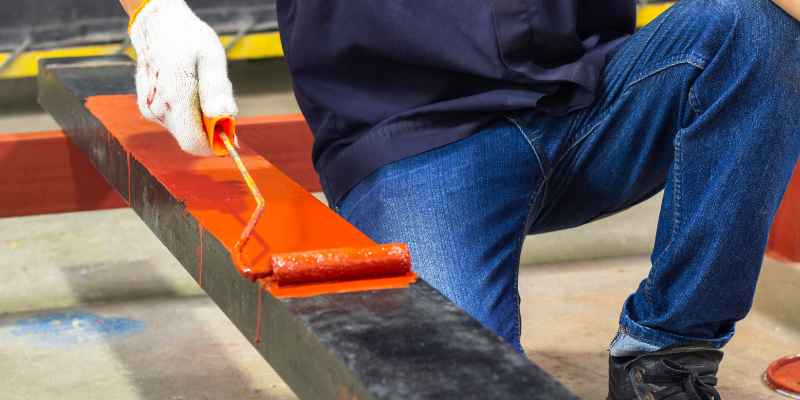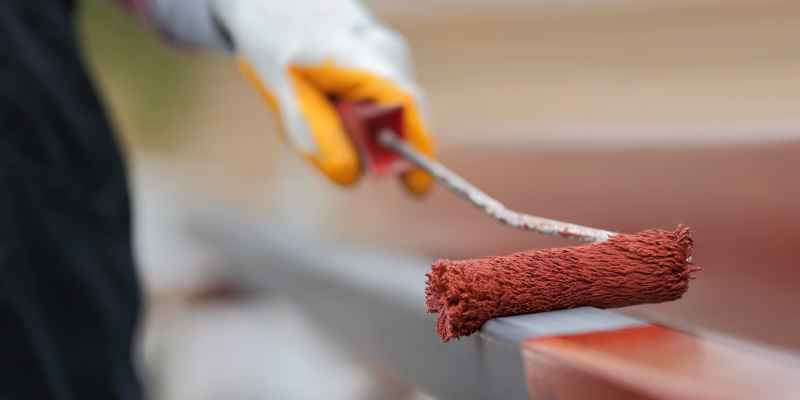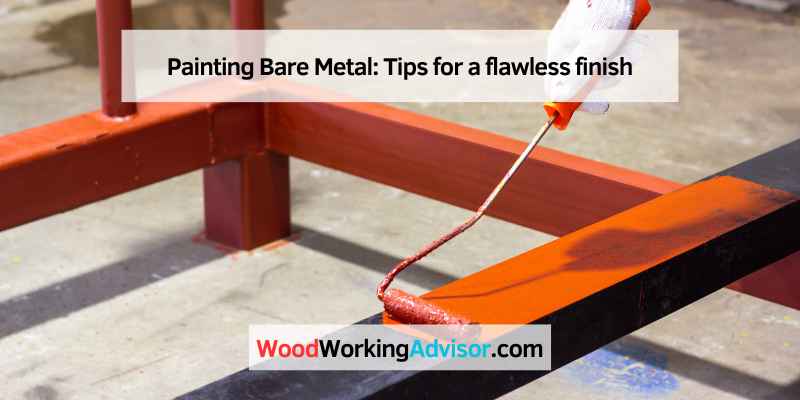To paint bare metal, prepare the surface by cleaning, sanding, and applying a primer. Proper surface preparation is essential for ensuring good adhesion and a long-lasting finish.
Choosing The Right Paint
When choosing paint for bare metal, consider durable enamel or epoxy paint for long-lasting results.
The right primer is crucial. For metal, use rust-inhibiting primers like zinc phosphate or iron oxide.
Primer helps prevent corrosion, improve adherence, and enhance paint durability.
Surface Preparation
Prepare the surface before painting bare metal with the proper cleaning, sanding, and priming techniques. This ensures a smooth and durable finish that will last.
Cleaning The Metal Surface Thoroughly
Cleaning the metal surface thoroughly is the first crucial step in painting bare metal. Before painting, it is important to remove any dirt, oil, rust, or other contaminants that may prevent the paint from adhering properly. This can be done using a mild detergent and water. For tougher dirt or grease, an automotive solvent or degreaser may be necessary. Ensure all surfaces are completely cleaned and dried before proceeding to the next step.
Sanding And Smoothing Imperfections
Sanding and smoothing imperfections play a vital role in achieving a flawless finish when painting bare metal. With the use of sandpaper, gently sand the entire metal surface to remove any rough spots, bumps, or unevenness. This step is crucial as it helps the paint adhere better, resulting in a more professional look. Remember to start with a coarser grit and gradually move to a finer grit to achieve a smooth surface. When sanding, be sure to wear safety goggles and a dust mask to protect yourself from any airborne particles.

Priming The Surface
When painting bare metal, priming the surface is a crucial step to ensure the best adhesion and longevity of the paint. The primer acts as a protective layer, preventing corrosion and providing a smooth base for the topcoat to adhere to. When done correctly, priming the surface can significantly enhance the durability and finish of the paint job. Here, we’ll explore the benefits of using a primer and the application techniques for priming bare metal surfaces.
Benefits Of Using A Primer
Using a primer when painting bare metal offers several key benefits:
- Corrosion Protection: The primer creates a barrier that shields the metal from rust and corrosion, extending the lifespan of the painted surface.
- Improved Adhesion: By promoting better adhesion between the metal and the topcoat, the primer helps prevent peeling and flaking, ensuring a long-lasting finish.
- Enhanced Durability: A primer provides added durability to the paint, making it more resistant to chipping, scratching, and environmental damage.
- Smooth Finish: It also helps to create a smooth and uniform surface, allowing the topcoat to go on more evenly and providing a professional-looking finish.
Application Techniques For Primer
Applying primer to a bare metal surface requires attention to detail and proper technique. Here are some key application techniques to consider:
- Clean the Surface: Start by thoroughly cleaning the metal surface to remove any dirt, grease, or rust. A clean surface ensures better adhesion for the primer.
- Use the Right Primer: Select a high-quality primer that is specifically designed for bare metal and compatible with the type of topcoat you plan to use.
- Apply Thin, Even Coats: Apply the primer in thin, even coats, allowing sufficient drying time between each layer. This helps to achieve a smooth and uniform base for the topcoat.
- Proper Drying Time: Allow the primer to fully cure according to the manufacturer’s instructions before applying the topcoat. This ensures proper bonding and long-term durability.
Paint Application
When it comes to painting bare metal, the paint application process plays a crucial role in achieving a durable and visually appealing finish. Proper paint application ensures that the metal surface is protected from rust and corrosion while enhancing its aesthetic appeal. In this section, we will delve into the key aspects of the paint application process, including choosing the right tools and employing techniques to achieve a smooth finish.
Choosing The Right Tools For Painting
Before embarking on the paint application process, it is essential to select the appropriate tools to ensure optimal results. Whether using spray paint, a paintbrush, or a roller, each tool serves a specific purpose in achieving a professional-looking finish.
- List of tools:
- Spray gun or aerosol spray can
- Paintbrushes with synthetic bristles
- Microfiber rollers
- Sanding blocks or sandpaper
- Each tool serves a specific purpose
Techniques For Achieving A Smooth Finish
Applying paint to bare metal requires precision and skill to ensure a smooth and even finish. Employing the right techniques can make a significant difference in the final outcome, enhancing the longevity and appearance of the paint job.
- Surface preparation is key
- Apply primer to enhance adhesion
- Use even strokes for consistent coverage
- Apply multiple thin coats for better adhesion

Drying And Curing
Proper drying and curing techniques are essential when painting bare metal to ensure a durable, long-lasting finish. This process helps prevent rust and corrosion, improving the overall longevity and appearance of the painted metal surface. Consistent application and thorough drying are key to achieving a smooth and professional result.
Ensuring Proper Ventilation For Drying
When painting bare metal, proper ventilation is crucial during the drying process. Good air circulation helps remove fumes and accelerate the drying time. Without adequate ventilation, the paint may not dry evenly, leading to unsightly streaks or patches. To ensure proper ventilation, it’s essential to position fans or open windows and doors to create a flow of fresh air. This will help the paint dry uniformly and reduce the risk of strong odors lingering in the room.
Understanding Curing Times
Curing, unlike drying, refers to the process of the paint reaching its maximum hardness and durability. While the paint may feel dry to the touch, it may still require additional time to fully cure. Curing times can vary depending on the type of paint used and environmental conditions. In general, it’s important to allow sufficient time for the paint to cure before subjecting it to any harsh conditions, such as scrubbing or exposure to extreme temperatures. This ensures a strong and long-lasting finish.
Ensuring Adequate Curing Time
To ensure proper curing, it’s crucial to follow the manufacturer’s instructions regarding the recommended curing time for the specific paint you’re using. Rushing the process can lead to premature damage or lackluster results. Allowing the paint to cure fully ensures that it will withstand everyday wear and tear, such as scratches and scuffs. During the curing process, it’s best to avoid placing objects or exerting pressure on the painted surface to prevent any unwanted imprints or blemishes.
Verifying The Paint Is Fully Cured
To verify if the paint has fully cured, perform a simple “touch test.” Gently press a finger on an inconspicuous part of the painted surface and observe if it leaves any marks or feels sticky. If the paint remains firm and doesn’t show any signs of damage or stickiness, it is likely fully cured. However, if it shows any negative outcomes, give it more time to cure before subjecting it to any heavy use or cleaning.
Achieving Optimal Results
By ensuring proper ventilation during the drying stage and allowing sufficient curing time, you can achieve optimal results when painting bare metal. These steps not only contribute to a more appealing finish but also enhance the durability and longevity of your painted surface. Remember to follow the manufacturer’s guidelines and take care not to rush the process. With patience and attention to detail, your painted bare metal will boast a beautiful and professional-looking finish.
Finishing Touches
Sanding For A Flawless Finish
Sanding is crucial for removing imperfections before painting bare metal. It ensures a smooth surface for flawless results.
Buffing And Polishing Techniques
Buffing and polishing give the painted metal a glossy shine. These techniques enhance the appearance of the metal.
Troubleshooting Common Issues
Whether you are a seasoned painter or a beginner, encountering issues when painting bare metal surfaces is common. Knowing how to troubleshoot and resolve these problems can save you time and effort in the long run.
Handling Paint Drips And Runs
- Wipe off excess paint immediately with a clean cloth.
- Gently sand the affected area to smooth out the drip or run.
- Apply a thin coat of paint over the sanded area for an even finish.
Dealing With Uneven Coverage
- Ensure proper surface preparation before painting.
- Apply multiple thin coats of paint rather than one thick coat.
- Use a high-quality paintbrush or spray gun for a smooth application.
Maintenance And Longevity
For painting bare metal, maintenance is key for longevity. Regular checks and touch-ups can prevent corrosion and ensure a lasting finish. Proper care extends the life of the paint job, preserving the metal’s appearance and durability.
Bare metal surfaces can be vulnerable to corrosion and rust if not properly maintained. Proper upkeep of the painted surface is essential to ensure its longevity. Here are some essential tips and reapplication strategies to maintain the integrity of bare metal paintings.
Tips For Preserving The Painted Surface
To preserve the bare metal painting, it is crucial to clean the surface regularly to remove any dirt or debris that can degrade the paint over time. Additionally, applying a protective clear coat can provide an extra layer of defense against environmental elements. When storing items with painted bare metal surfaces, ensure they are housed in a controlled environment to prevent exposure to moisture and harsh conditions.
Reapplication And Touch-up Strategies
Regularly inspect the painted surface for any signs of damage or wear. In the event of any imperfections, it is important to promptly address touch-ups to prevent further deterioration. When reapplying paint, thoroughly clean the surface and use high-quality, rust-inhibiting paint to ensure a long-lasting finish. Additionally, consider utilizing rust converters before repainting to effectively halt any corrosion.
By following these maintenance and reapplication strategies, the painted bare metal surface can maintain its integrity and longevity, ensuring it remains an enduring and aesthetically pleasing feature.
Frequently Asked Questions Of Painting Bare Metal
How To Prepare Bare Metal For Painting?
To prepare bare metal for painting, start by cleaning the surface with a degreaser. Next, use a metal etching primer to promote adhesion. Lastly, apply a rust-inhibiting primer before top coating with paint.
What Type Of Paint Should I Use On Bare Metal?
For painting bare metal, it’s best to use a direct-to-metal (DTM) paint or a rust-inhibitive enamel paint. These types of paints are specifically formulated to adhere to and protect metal surfaces.
How Can I Prevent Rust On Newly Painted Metal?
To prevent rust on newly painted metal, ensure the surface is thoroughly cleaned and primed before painting. Additionally, apply a quality top coat designed to resist rust and environmental elements.
Can I Paint Bare Metal Without Priming First?
Priming bare metal before painting is essential for proper adhesion and long-term durability. Skipping the priming step can lead to paint failure and an increased risk of corrosion.
Conclusion
To achieve a professional and long-lasting result, painting bare metal requires careful planning, preparation, and the right products. Priming the surface, choosing the appropriate type of paint, and applying multiple coats are essential steps in achieving a smooth and durable finish.
By following these steps and taking the time to properly prepare and paint, you can transform your bare metal into a beautiful and lasting piece that will withstand the test of time. Experience the satisfaction of turning raw metal into a work of art!


